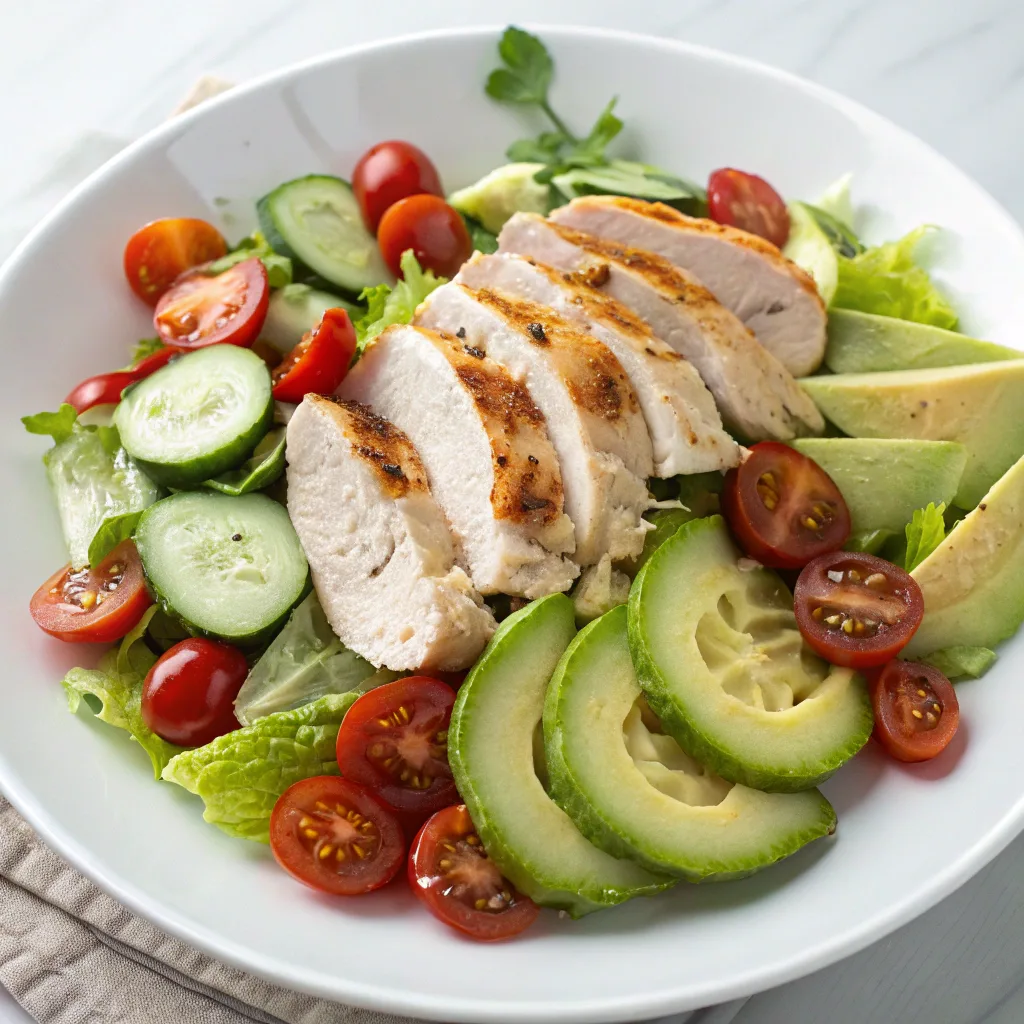Chicken salad has become a popular dish, often seen as a quick and nutritious meal. But the question remains: is chicken salad actually healthy? While it is widely regarded as a healthy option, it’s important to examine its components more closely. The healthiness of chicken salad depends on several factors, including the ingredients used, the preparation methods, and the overall balance of nutrients. In this article, we will try the various aspects of chicken salad, from its nutritional value to potential drawbacks, and give you the tools to make the healthiest version of this dish.
The Nutritional Value of Chicken Salad: Is It Healthy?
When evaluating is chicken salad actually healthy, it’s crucial to first consider its nutritional profile. The overall healthiness of chicken salad varies greatly depending on the ingredients and how it’s made. However, chicken, as a lean source of protein, can provide numerous health benefits.
Protein in Chicken Salad: A Key to Its Health Benefits
One of the primary reasons chicken salad is often viewed as healthy is due to its high protein content. Chicken, particularly chicken breast, is rich in lean protein, which is essential for muscle repair, immune function, and overall body maintenance. Including chicken in your salad provides a significant portion of your daily protein needs, which is an important factor when determining if chicken salad is actually healthy.
- Protein helps with satiety: Chicken salad is a filling meal, which can help curb hunger and keep you full for longer. This is particularly beneficial for those trying to control their calorie intake or avoid snacking throughout the day.
- Protein helps in muscle recovery: For those who are physically active or engage in regular workouts, protein from chicken supports muscle repair and growth.
On average, a serving of chicken salad can provide 20–30 grams of protein, making it a substantial option for anyone looking to boost their protein intake.
Essential Vitamins and Minerals in Chicken Salad
In addition to protein, chicken salad contains a variety of vitamins and minerals, especially when made with fresh vegetables. Depending on the vegetables you include in your chicken salad, it may contain several essential nutrients, such as:
- Vitamin A from leafy greens like spinach, kale, or lettuce. This vitamin is important for eye health, immune function, and skin health.
- Vitamin C from vegetables like bell peppers, tomatoes, or broccoli. Vitamin C helps with the absorption of iron and supports immune health.
- Potassium from ingredients such as avocado or celery. Potassium helps regulate fluid balance and supports healthy blood pressure.
Therefore, chicken salad can be a great source of essential nutrients. When prepared with a variety of colorful vegetables, chicken salad provides a wide range of micronutrients, making it not only a protein-packed meal but also one rich in vitamins and minerals.
What Makes Chicken Salad Healthy? Variations and Ingredients
The combination of chicken, vegetables, and healthy fats (from ingredients like avocado or olive oil) makes chicken salad a highly nutritious meal. The inclusion of protein, vitamins, minerals, and healthy fats contributes to overall wellness and supports several bodily functions, including:
- Boosting immunity: With the high vitamin C and A content in the vegetables, chicken salad supports a healthy immune system.
- Supporting heart health: The healthy fats found in ingredients like avocado and olive oil are beneficial for heart health, contributing to balanced cholesterol levels.
Thus, chicken salad is a nutrient-dense meal when made with the right ingredients, providing a range of health benefits.
For more on healthy meal options, check out our article on 10 Healthy Salad Recipes for a Balanced Diet.
Variations of Chicken Salad
Chicken salad can vary greatly depending on the ingredients and preparation methods. Whether you prefer a traditional version or a more modern twist, there are countless variations of chicken salad, and they can impact its overall healthiness. So, when you ask is chicken salad actually healthy, it’s important to know how you’re preparing it.
Traditional vs. Modern Chicken Salad
Traditional chicken salad often relies on mayonnaise or creamy dressings, which can increase the calorie and fat content significantly. While mayonnaise provides a creamy texture, it’s also high in fat and calories, which may detract from the overall healthiness of the salad.
- Traditional chicken salad typically contains ingredients like chicken, mayonnaise, celery, and onions. While this is a tasty option, the dressing’s high-fat content can increase the calorie count, which may not be suitable for those watching their fat intake or seeking a lower-calorie meal.
However, modern chicken salad recipes have evolved to provide lighter, healthier options that make the salad even more nutritious. Instead of mayonnaise, some people opt for Greek yogurt, avocado, or olive oil as the dressing base, reducing fat and calories.
- Greek yogurt-based dressings: Greek yogurt provides a creamy texture with fewer calories and more protein than mayonnaise.
- Avocado-based dressings: Avocado offers healthy fats, which are beneficial for heart health and can improve the flavor and texture of the chicken salad.
- Mustard or vinaigrette dressings: These provide a tangy flavor with little to no calories and fat, making them a great choice for those looking for a lighter option.
With these modern dressings, chicken salad can remain a tasty and nutritious meal while being lower in calories and fat.
Chicken Salad with Vegetables
Another way to increase the health value of chicken salad is by incorporating more vegetables. Vegetables not only add crunch and texture but also provide an extra boost of vitamins, minerals, and fiber. When asking is chicken salad actually healthy, increasing the vegetable content makes a significant difference.
Some great vegetables to include are:
- Leafy greens: Spinach, arugula, or romaine lettuce add essential vitamins and fiber to the salad.
- Bell peppers: Rich in vitamin C, they add vibrant color and flavor to the dish.
- Cucumbers and carrots: These crunchy vegetables provide fiber and low-calorie volume, helping you feel fuller without adding too many calories.
Incorporating a variety of vegetables into your chicken salad increases its nutritional profile, making it a more balanced and healthful meal.
Dressing Choices
As mentioned earlier, the choice of dressing is crucial when considering is chicken salad actually healthy. Some dressings can be loaded with unhealthy fats, sugars, and preservatives, which reduce the health benefits of the salad. Opting for homemade or lighter dressings can improve the dish’s health value.
- Vinaigrettes: A simple vinaigrette made with olive oil and vinegar offers healthy fats with minimal calories.
- Greek yogurt dressing: Adding a tablespoon of Greek yogurt as a base creates a creamy texture without the high-fat content of mayonnaise.
The right dressing can einforce the flavor of your chicken salad without compromising its healthiness.
How Chicken Salad Fits Into Your Diet: Healthy Meal Choices
Chicken salad is a versatile dish that can be adapted to fit many different dietary needs. Whether you’re following a keto, low-carb, or weight loss-focused diet, chicken salad can easily be modified to align with your goals. So, let’s examine how chicken salad is actually healthy in different dietary contexts.
Chicken Salad on a Keto Diet: Is It a Low-Carb Option?
For those on a keto diet, chicken salad can be an excellent option, as it can be high in protein and fats while being low in carbohydrates. The key is to choose low-carb vegetables and avoid any high-carb add-ins, like croutons or fruits. By sticking to vegetables like leafy greens, cucumbers, and avocado, you can keep the salad keto-friendly.
Additionally, you should opt for full-fat dressing options, such as olive oil or avocado-based dressings, to increase the healthy fat content.
Chicken Salad for Weight Loss: A Healthy Choice for Dieters
When asking is chicken salad actually healthy for weight loss, the answer is yes, but portion control and ingredient choices are key. Chicken salad can be a filling, nutrient-dense meal that helps you manage your hunger and caloric intake. By choosing lean chicken, reducing calorie-dense dressings, and adding more vegetables, you can keep the salad lower in calories while still providing your body with a satisfying, nutritious meal.
For a weight-loss-friendly chicken salad:
- Choose lean cuts of chicken breast to lower fat content.
- Use homemade dressings or low-fat options.
- Add plenty of vegetables to boost fiber and bulk up the salad without adding extra calories.
Chicken salad is ideal for weight loss as it’s low in calories yet high in protein, which helps with satiety and reduces overeating.
Potential Drawbacks of Chicken Salad: Health Risks to Consider
While chicken salad can be a healthy meal option, it’s not without its potential drawbacks. These drawbacks can occur depending on the ingredients used and how the salad is prepared. If you’re wondering is chicken salad actually healthy in all forms, it’s important to be aware of these factors.
High-Calorie Dressings and Add-ins in Chicken Salad
One of the main issues with chicken salad is the calorie content of the dressing and added ingredients. Traditional dressings like mayonnaise can be high in fat and calories, which increases the overall calorie count of the salad. Additionally, add-ins like cheese, bacon, and nuts can quickly escalate the calorie count, which may make it less suitable for certain diets.
To maintain a healthy chicken salad, choose low-calorie dressings and limit calorie-dense add-ins. Opt for healthy fats, such as avocado, and use nuts sparingly to avoid excess calories.
How to Make Chicken Salad Healthier: Smart Modifications
If you’re looking for ways to make your chicken salad healthier, there are several modifications you can make. These adjustments can reduce the calorie content, increase the nutritional value, and secure that your chicken salad remains a healthful meal option.
Choosing Lean Chicken for a Healthier Chicken Salad
To make chicken salad healthier, choose lean cuts of chicken like chicken breast, which are lower in fat and calories compared to darker cuts of chicken. Skinless chicken breast is the healthiest choice for a lean, protein-packed salad.
Reducing Calories in Chicken Salad Dressings
Rather than using store-bought mayonnaise or other high-calorie dressings, opt for homemade dressings. Greek yogurt, mustard, olive oil, and vinegar-based dressings can add flavor while keeping the calorie count low. These options provide a healthy balance of protein, healthy fats, and minimal sugar.
Incorporating More Vegetables to Boost Nutrition
Adding more vegetables is one of the easiest ways to increase the health benefits of your chicken salad. More vegetables mean more fiber, more vitamins, and a lower overall calorie count. Veggies like leafy greens, cucumbers, and tomatoes not only add nutrition but also einforce the texture and flavor of the salad.
FAQs About Chicken Salad’s Healthiness
Let’s address some frequently asked questions about chicken salad to further clarify its health benefits and help you make the best choices when preparing this dish.
Can Chicken Salad Help with Weight Loss?
Yes, chicken salad can aid in weight loss if it’s prepared with lean chicken and light dressings. The high protein content keeps you full for longer, helping to curb overeating.
Is Chicken Salad High in Calories?
It can be, especially if made with calorie-dense dressings or add-ins like cheese and nuts. To keep it healthy, opt for lean chicken, low-calorie dressings, and add plenty of vegetables.
Can Chicken Salad Be Part of a Low-Carb Diet?
Yes, chicken salad can easily be part of a low-carb diet as long as you avoid high-carb ingredients like croutons, fruits, or sugary dressings. Stick to low-carb vegetables and healthy fats like avocado.
What Are the Best Chicken Salad Dressings?
The best dressings for chicken salad are homemade vinaigrettes, Greek yogurt-based dressings, or avocado-based dressings. These options are healthier than store-bought dressings, which often contain preservatives and added sugars.
Is Chicken Salad Actually Healthy? Final Thoughts on Its Nutritional Value
Yes, especially if you choose lean chicken and healthy fats like olive oil or avocado. The high protein and low saturated fat content can help support cardiovascular health.
Conclusion: Summarizing the Healthiness of Chicken Salad
In conclusion, is chicken salad actually healthy? Yes, when prepared with healthy ingredients like lean chicken, fresh vegetables, and light dressings, chicken salad can be a nutritious and filling meal. It provides a wealth of protein, vitamins, minerals, and healthy fats, making it a well-rounded option for anyone looking to eat healthier. However, it’s essential to be mindful of the ingredients you use, especially the dressing and add-ins, to secure that the dish remains healthy. By making smart choices, you can enjoy chicken salad as part of a balanced, health-conscious diet.


